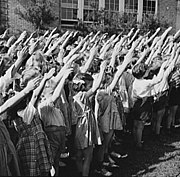Bellamy salute
From Wikipedia, the free encyclopedia
The Bellamy salute is the hand gesture described by Francis Bellamy (1855-1931) to accompany the American Pledge of Allegiance, which he had authored. The gesture was derived from the Roman salute. During the period when it was used with the Pledge of Allegiance, it was sometimes known as the "flag salute". It was first demonstrated on October 12, 1892 according to Bellamy's published instructions for the "National School Celebration of Columbus Day":
At a signal from the Principal the pupils, in ordered ranks, hands to the side, face the Flag. Another signal is given; every pupil gives the flag the military salute -- right hand lifted, palm downward, to a line with the forehead and close to it. Standing thus, all repeat together, slowly, “I pledge allegiance to my Flag and the Republic for which it stands; one Nation indivisible, with Liberty and Justice for all.” At the words, “to my Flag,” the right hand is extended gracefully, palm upward, toward the Flag, and remains in this gesture till the end of the affirmation; whereupon all hands immediately drop to the side.
– From The Youth’s Companion, 65 (1892): 446–447.
The initial civilian salute was replaced with a hand-on-heart gesture, followed by the extension of the arm as described by Bellamy.
In the 1920s, Italian fascists adopted the Roman salute to symbolise their claim to have revitalised Italy on the model of ancient Rome. This was quickly copied by the German Nazis, creating the Nazi salute. The Nazi salute was therefore similar to the Bellamy salute, as they were both ultimately based on the Roman salute. This similarity led to confusion, especially during World War II. From 1939 until the attack on Pearl Harbor, detractors of Americans who argued against intervention in World War II produced propaganda using the salute to lessen those Americans' reputations. Among the anti-interventionist Americans was aviation pioneer Charles Lindbergh. Supporters of Lindbergh's views would claim that Lindbergh did not support Adolf Hitler, and that pictures of him appearing to do the Nazi salute were actually pictures of him using the Bellamy salute.[1] In his Pulitzer prize winning biography Lindbergh, author A. Scott Berg explains that interventionist propagandists would photograph Lindbergh and other isolationists using this salute from an angle that left out the American flag, so it would be indistinguishable from the Hitler salute to observers.
In order to prevent further confusion or controversy, President Franklin D. Roosevelt instituted the hand-over-the-heart gesture as the salute to be rendered by civilians during the Pledge of Allegiance and the national anthem in the United States, instead of the Bellamy salute. This was done when Congress officially adopted the Flag Code on 22 June 1942. [2] There was initially some resistance to dropping the Bellamy salute, by for example the Daughters of the American Revolution group [3], but this opposition died down quickly.
[edit] See also
[edit] References
- ^ Is Lindbergh a Nazi?, charleslindbergh.com, http://www.charleslindbergh.com/pdf/Lindbergh.pdf, retrieved on 2008-04-21
- ^ Leepson, Marc (2006). Flag: An American Biography. Macmillan. pp. 171. ISBN 0312323093.
- ^ Fried, Richard M. (1999). The Russians Are Coming! The Russians Are Coming!: Pageantry and Patriotism in Cold-War America. New York: Oxford University Press (USA). pp. 12. ISBN 0-19-513417-6.
[edit] External links
|
|||||||||||||||||||||||||||||




